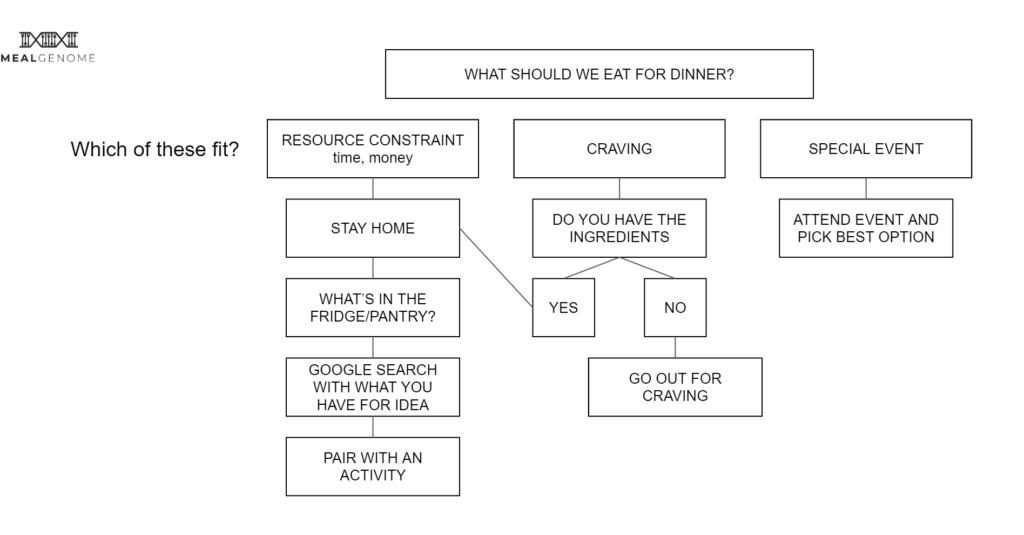
What should we eat for Dinner?

How many times a week do you ask “what should we eat for dinner?” I ask this question, or a variation of it, every day. On the weekend, when constraints of the routine are gone, we seem to ask this question for every meal. At times, it seems like the essence of my relationships is an endless cycle of solving for this question.
Me: “What should we eat for dinner?” Wife: “I don’t know, what sounds good?” Me: “Italian” Wife: “Meh” Me: “Mexican” Wife: “Meh, nothing sounds good.” Me: “Do you want to go out or stay home?” Wife: “Do you really want to pack the kids up?” Me: “Ok, let’s stay home. What do we have in the fridge?” Wife: “Chicken” Me: “Ok, I will make something with chicken.”

I know I am not alone. Family, friends, and memes tell me this is a dilemma many household face on a regular basis. Tools abound to help find answers but the question persists. Why is this problem unsolved? In many ways, I think the problem is getting worse. Busy schedules, culinary skills, and changing food preferences make this problem especially difficult.
Certainly, this fits into the first world problem category. If you were really hungry, you would accept whatever you could find. Therein is the underlying cause, at root, it is a symptom of too many choices. However, this is a modern problem that will continue to plague households of developed nations.
Pantry Scraps to Search
So, an option to solve the problem is to wait until you are really hungry. Then you will either crave something or accept anything. Thank me when your slamming pickles from the jar you forgot at the back of the fridge.
Ok, so you don’t want to ravage pantry scraps in a hunger induced fit. You can think of hundreds of things but can’t pick the one thing you want. The problem gets harder as you try to solve for something that fits across a bigger group. Sometimes, there is the pressure of a deadline. It’s time to eat, the kids are hangry, time to decide. Figuring out “what should we eat for dinner” is a common decision making problem.
My least favorite, but an option, is the process of elimination. Ask the parties what they are not “in the mood for.” Are there cuisines you can eliminate? If you’re in the US, you can probably whittle it down to Italian, Chinese, American or Mexican. Diet restrictions also help quickly eliminate options. Finally, discuss resource restrictions. Short on time, trying to save money, or limited transportation options can zone in on possible options to get to a decision faster.

Concede to a Different Power
Instead of deciding, sometimes getting to a satisfactory decision means putting the power of meal choice in the hands of someone else. There are decision making strategies that shift power.
Give it to Social – if you have a few options but just cant decide, post it to Facebook or text a random friend. Then take the decision from the social network
Old Fashion Diplomacy – Use the 3/1 Compromise. One person in the group gets to name three options. No debate on the options and the other members of the group get to vote to select one of the 3 options.
Share the Lead – have a rotation of who makes the decision. The non leaders submit a list of possible options, the leader picks. Non leaders get one veto.
Search – If you’re like me, when you can’t decide what to eat, I betting you next move is to pick up your phone and search for ideas. Type “what should we eat for dinner” into Google search. First, you will get a set of local restaurants. If you decide to go out, this leaves you, the searcher, left to try and match restaurant options to the preferences of your entire meal participants. Ratings and reviews help but leave significant effort on you.
Next, the search will return numerous recipe compilations. If you decide to eat at home, you will need to solve for a recipe that fits your parties preferences. Recipe sites offer filters and categories but matching to diet needs and flavor preferences can be tricky. Then you will need to match to your available groceries or head to the store.
Tools to the Rescue
After your local restaurant hot spots and the recipe lists there are recipe generators that allow you to search by ingredients you have at home. This leaves the preference matching problem for you and the group to decide from a subset of recipes that fit your available ingredients. Supercook is one such tool. Though, I find if I type the chief ingredients I have into a Google search, I end up with fairly good suggestions for on hand ingredients.
A unique tool if you’re willing to just let the internet decide for you, try Recipe Roulette. The tool takes user input on cuisine preference, main ingredient and dietary requirements then provides a selection with a picture and a recipe. I ran it with no user input and listed a week’s worth of suggested dinners below. I like the frequency of dessert recommendations!
- Apple Meringue Cake
- Moist Lemon Yogurt Muffins
- Ciabatta with Feta and Roasted Vegetables
- Quick Bap Pizzas
- Pineapple Glazed Ham
- Apple Pie Spice
- Mike’s Tequila Mussels
Quizony offers a quiz to recommend a dish. It requires answers to 29 questions, capturing preferences from your favorite fast food to the strangest food you would try. Quizony’s answer to “what should we eat for dinner” from my responses was massaged kale salad. Hmm?
Or, you could just go with what is popular. According to Healthline, these are the most popular dinner dishes in the United States:
- Rice +Chicken + Salad
- Potato + Cheese + Beans
- Bread + Eggs + Bell Pepper
- Fries + Beef + Tomato
- Quinoa + Turkey + Broccoli
- Couscous + Pork + Spinach
The Meal Genome Way

We try to keep it simple in our house. With three kids five and under, there is a stop watch that starts when we enter a restaurant. When that clock hits sixty minutes, we know someone is likely to have a breakdown. If we make it that long. So, we stay home unless we have a major craving or a special event. It is a resource driven decision on limited time for a meal.
We also watch our meal budget to save up for dream meal experiences. Recreated leftovers spruced up and paired with a fun activity are a common dinner. Leftovers are a great way to rack up savings to splurge on an indulgent experience down the road.
I personally, enjoy the challenge of taking what we have and trying to make a dish. Google makes it so easy. Just type in the main ingredients you have and chance are, you will find several recipes with reviews that fit for the available ingredients.
When my spouse or I have a major craving, we see if we have the ingredients at home. If not, this is a time we will go out and risk a restaurant kid breakdown.
If you’re struggling with planning meals, try making a list of Ten Meals at the start of every month. This can be your go to rotation. Use five family favorites and use five leveraging an in season food item. Every week, just pull from this for your at home meals. This reduces the burden of choice and makes grocery planning easier.
I plan to provide my list of Ten Meals in my monthly email newsletter for you to steal from freely for your meal planning. The email newsletter will also provide insights into hot food trends based on search traffic.
How do you answer the “what should we eat for dinner” question? Write your approach in the comments.
Author

Dan Kurdys is a dad that cooks at home for his wife and three daughters. Growing up, meals were a critical part of Dan’s learning and family bonding. He feels the struggle of balancing a full time job and preparing family meals that are convenient, on budget and healthy. He started his side hustle blog Meal Genome in 2018 to discover insights for better meal experiences. The approach is to use skills from career experience in corporate strategy, a MBA and a degree in Economics toward analytics of meal experiences.